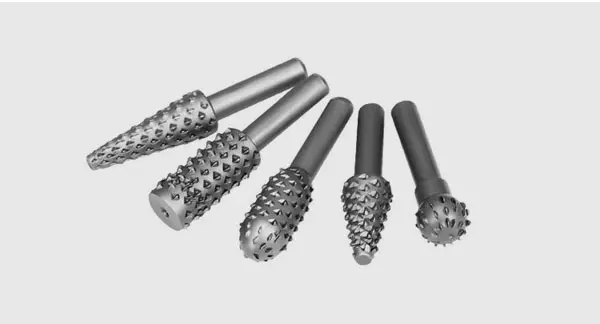
Tips for Using Hard Metal Tungsten Carbide Rotary Files for Deburring
Cemented carbide rotary files are mainly composed of high-hardness, refractory metal carbides (WC, TiC) micron powders, cobalt (Co), nickel (Ni), and molybdenum (Mo) as binders. Or powder metallurgy products sintered in a hydrogen recovery furnace. The carbides, nitrides, borides, etc. of group ⅣB, ⅤB, and VIB metals are collectively called hard alloys because of their extremely high hardness and melting point.
Teach you the principles of selection.
1 Selection of cross-section shape of hard alloy rotary file
The cross-sectional shape of the carbide rotary file cutter should be selected according to the shape of the filed part so that the two shapes are compatible. When filing the inner arc surface, you should choose a semicircular file or a round file (small diameter workpiece); when filing inner corner surface, you should choose a triangular file; when filing the inner right-angle surface, you can choose a flat file or a square file. When using a flat file to file the inner right-angled surface, pay attention to making a narrow surface (smooth edge) of the file without teeth close to the inner right-angled surface to avoid scratching the right-angled surface.

2 Choice of file tooth thickness
The thickness of the teeth of the file should be selected according to the size of the workpiece allowance, machining accuracy, and material properties. Coarse-tooth files are suitable for machining workpieces with large allowance, low dimensional accuracy, large geometric tolerances, large surface roughness values, and soft materials; otherwise, fine-tooth files should be selected. When used, it should be selected according to the required machining allowance, dimensional accuracy, and surface roughness of the workpiece.

3 Selection of alloy file size specifications
Carbide rotary file size specifications should be selected according to the size of the workpiece to be processed and machining allowance. When processing size is large and margin is large, a file of large size should be used, and a file of small size should be used on contrary.

4 Selection of file tooth pattern
The tooth pattern of the tungsten steel grinder file should be selected according to the nature of the material to be filed. When filing soft materials such as aluminum, copper, mild steel, etc., it is best to use a single-tooth (milling tooth) file. The single-tooth file has a large rake angle, small wedge angle, and large chip pocket, the chip is not easy to block, and the cutting edge is sharp.